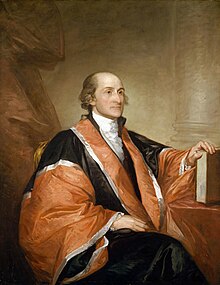
Back جون جاي Arabic جون جاى (محامى) ARZ Con Cey Azerbaijani جان جی AZB Джон Джэй Byelorussian Джон Джей Bulgarian John Jay Catalan John Jay Czech John Jay Danish John Jay German
John Jay | |
|---|---|
 Portrait by Gilbert Stuart, 1794 | |
| 1st Chief Justice of the United States | |
| In office October 19, 1789 – June 29, 1795 | |
| Nominated by | George Washington |
| Preceded by | Office established |
| Succeeded by | John Rutledge |
| 2nd Governor of New York | |
| In office July 1, 1795 – June 30, 1801 | |
| Lieutenant | Stephen Van Rensselaer |
| Preceded by | George Clinton |
| Succeeded by | George Clinton |
| United States Secretary of State | |
| Acting September 15, 1789 – March 22, 1790 | |
| President | George Washington |
| Preceded by | Office established |
| Succeeded by | Thomas Jefferson |
| United States Secretary of Foreign Affairs | |
| Acting July 27, 1789 – September 15, 1789 | |
| President | George Washington |
| Preceded by | Himself |
| Succeeded by | Office abolished |
| In office December 21, 1784 – March 3, 1789 | |
| Appointed by | Congress of the Confederation |
| Preceded by | Robert R. Livingston |
| Succeeded by | Himself |
| United States Minister to Spain | |
| In office September 27, 1779 – May 20, 1782 | |
| Appointed by | Second Continental Congress |
| Preceded by | Office established |
| Succeeded by | William Short |
| 6th President of the Continental Congress | |
| In office December 10, 1778 – September 28, 1779 | |
| Preceded by | Henry Laurens |
| Succeeded by | Samuel Huntington |
| Delegate from New York to the Second Continental Congress | |
| In office December 7, 1778 – September 28, 1779 | |
| Preceded by | Philip Livingston |
| Succeeded by | Robert R. Livingston |
| In office May 10, 1775 – May 22, 1776 | |
| Preceded by | Seat established |
| Succeeded by | Seat abolished |
| Delegate from New York to the First Continental Congress | |
| In office September 5, 1774 – October 26, 1774 | |
| Preceded by | Seat established |
| Succeeded by | Seat abolished |
| Personal details | |
| Born | December 23, 1745 New York City, Province of New York |
| Died | May 17, 1829 (aged 83) Bedford, New York, U.S. |
| Political party | Federalist |
| Spouse | |
| Children | 6, including Peter and William |
| Relatives | Jay family Van Cortlandt family |
| Education | King's College (AB, MA) |
| Signature | |
John Jay (December 23 [O.S. December 12], 1745 – May 17, 1829) was an American statesman, patriot, diplomat, abolitionist, signatory of the Treaty of Paris, and a Founding Father of the United States. He served as the second governor of New York and the first chief justice of the United States. He directed U.S. foreign policy for much of the 1780s and was an important leader of the Federalist Party after the ratification of the United States Constitution in 1788.
Jay was born into a wealthy family of merchants and New York City government officials of French Huguenot and Dutch descent. He became a lawyer and joined the New York Committee of Correspondence, organizing American opposition to British policies such as the Intolerable Acts in the leadup to the American Revolution. Jay was elected to the First Continental Congress, where he signed the Continental Association, and to the Second Continental Congress, where he served as its president. From 1779 to 1782, Jay served as the ambassador to Spain; he persuaded Spain to provide financial aid to the fledgling United States. He also served as a negotiator of the Treaty of Paris, in which Britain recognized American independence. Following the end of the war, Jay served as Secretary of Foreign Affairs, directing United States foreign policy under the Articles of Confederation government. He also served as the first Secretary of State on an interim basis.
A proponent of strong, centralized government, Jay worked to ratify the United States Constitution in New York in 1788. He was a co-author of The Federalist Papers along with Alexander Hamilton and James Madison, and wrote five of the eighty-five essays. After the establishment of the new federal government, Jay was appointed by President George Washington the first Chief Justice of the United States, serving from 1789 to 1795. The Jay Court experienced a light workload, deciding just four cases over six years. In 1794, while serving as chief justice, Jay negotiated the highly controversial Jay Treaty with Britain. Jay received a handful of electoral votes in three of the first four presidential elections but never undertook a serious bid for the presidency.
Jay served as the governor of New York from 1795 to 1801. Although he successfully passed gradual emancipation legislation as governor of the state, he owned five slaves as late as 1800. In the waning days of President John Adams' administration, Jay was confirmed by the Senate for another term as chief justice, but he declined the position and retired to his farm in Westchester County, New York.